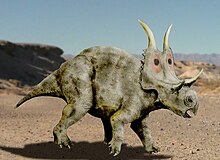Diabloceratops
| Diabloceratops | ||||||||||||
|---|---|---|---|---|---|---|---|---|---|---|---|---|

Skull of Diabloceratops (right), top left the skull of Nasutoceratops |
||||||||||||
| Temporal occurrence | ||||||||||||
| Upper Cretaceous (Lower and Middle Campanium ) | ||||||||||||
| 83.6 to 76.4 million years | ||||||||||||
| Locations | ||||||||||||
| Systematics | ||||||||||||
|
||||||||||||
| Scientific name | ||||||||||||
| Diabloceratops | ||||||||||||
| Kirkland & DeBlieux , 2010 | ||||||||||||
| Art | ||||||||||||
|
||||||||||||
Diabloceratops (from ancient Greek Διάβολος Diábolos 'devil', κέρας kéras 'horn' and ὤψ ōps 'face'; literally meaning 'face with devil's horns') was a genus of bird basin dinosaurs (Ornithischia) from the group of Ceratopsia . The herbivore Diabloceratops lived in North America, where he in 2002 Wahweap Formation in the area of Grand Staircase-Escalante National Monument in the US - state of Utah was discovered. The holotype specimen consists of an almost completely preserved skull. Another fragmentary skull could also belong to this genus.
features
Diabloceratops reached a length of about 3.5 meters and a height of 1.2 meters, its weight is estimated at 150 kilograms.
The most striking feature is its ruff and curved horns head, from which it owes its name.
Systematics
|
||||||||||||||||||||||||||||||||||||||||||||||||||||||||||||||||||||||||||||||||||||||||||
| Systematic position of Diabloceratops according to Evans & Ryan (2015). |
Diabloceratops is one of the Ceratopsidae . In 2015, the family tree of the Centrosaurinae was revised by Evans & Ryan (2015) on the occasion of the first description of the Wendiceratops found in Canada . Accordingly, Diabloceratops is the most basal genus and the sister taxon of all other known Centrosaurinae, followed by a common taxon from Nasutoceratops and Avaceratops . In a phylogenetic analysis in 2012, Xenoceratops was considered the most basal genus of the Centrosaurinae and compared to all other known genera including the Diabloceratops .
literature
- James I. Kirkland, Donald D. DeBlieux: New basal centrosaurine ceratopsian skulls from the Wahweap Formation (Middle Campanian), Grand Staircase-Escalante National Monument, southern Utah. In: Michael J. Ryan, Brenda J. Chinnery-Allgeier, David A. Eberth: New Perspectives on Horned Dinosaurs. The Royal Tyrrell Museum Ceratopsian Symposium. Indiana University Press, Bloomington IN et al. 2010, ISBN 978-0-253-35358-0 , pp. 117-140, digitized .
Individual evidence
- ^ Gregory S. Paul : The Princeton Field Guide To Dinosaurs. Princeton University Press, Princeton NJ et al. 2010, ISBN 978-0-691-13720-9 , p. 258, online .
- ↑ David C. Evans , Michael J. Ryan : Cranial Anatomy of Wendiceratops pinhornensis gen. Et sp. nov., a Centrosaurine Ceratopsid (Dinosauria: Ornithischia) from the Oldman Formation (Campanian), Alberta, Canada, and the Evolution of Ceratopsid Nasal Ornamentation. PLOS ONE 10 (7): e0130007. doi : 10.1371 / journal.pone.0130007 .
- ↑ Michael J. Ryan, David C. Evans, Kieran M. Shepherd: A New Ceratopsid from the Foremost Formation (Middle Campanian) of Alberta. In: Canadian Journal of Earth Sciences , Vol. 49, No. 11, 2012, ISSN 0008-4077 , pp. 1251-1262, doi : 10.1139 / e2012-056 .
